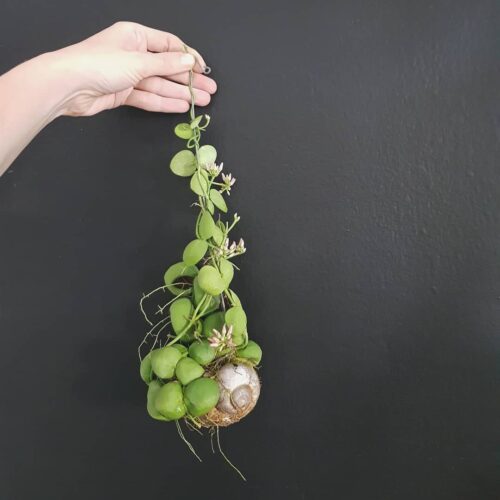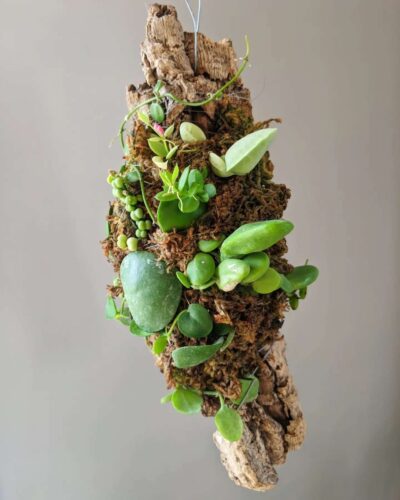Dischidia Pectinoides can be a great addition to your indoor garden if you want to grow it in your home; read all the information below.
Dischidia Pectinoides, a charming trailing plant, is a favorite among indoor gardeners. The pouch-shaped leaves and unique growth pattern make it a delightful addition to any home. Learn how to care for and cultivate this beauty in our comprehensive guide.
USDA Zones: 10 and 11
Learn Growing Dischidia Geri in the Pots HERE
Dischidia Pectinoides Plant Profile

Dischidia pectinoides belongs to the Apocynaceae family. It is native to Southeast Asia, including countries like Malaysia and Indonesia. This small, trailing epiphytic plant features thick, green succulent leaves.
It exhibits a moderate growth rate, typically reaching a height of 6 to 12 inches. The Dischidia pectinoides display inconspicuous white or creamy flowers that lack any fragrance.
The leaves are oval-shaped and glossy, often forming pockets that can catch rainwater or debris, giving this plant its unique character. Often used as a decorative houseplant in hanging baskets or terrariums, it’s also known as the “Ant Plant” due to its tendency to host certain ant species for shelter and sustenance. For optimal growth, Dischidia pectinoides require bright, indirect light and should be watered sparingly, allowing the soil to dry between waterings.
Read Tips to grow Dischidia hirsuta ‘Red Leaf’ HERE
How to Propagate Dischidia Pectinoides
Propagating Dischidia pectinoides can be done through several methods, including stem cuttings. Here’s a step-by-step guide on how to propagate this plant:
- Choose a healthy, mature stem from the parent plant. Look for a stem that is at least a few inches long and has several leaves on it.
- Use a clean, sharp pair of scissors or pruning shears to make a clean cut just below a leaf node. Ensure that the cutting has at least one leaf attached.
- Let the cut end of the stem cutting air dry for a day or two. This helps to prevent rot when it’s planted.
- Fill a small pot with a well-draining potting mix. Make a small hole in the soil using a stick or your finger, and insert the cut end of the stem cutting into the hole. Gently press the soil around the cutting to secure it.
- Water the cutting lightly to settle the soil around it. Avoid overwatering, as excessive moisture can cause rot.
- To maintain high humidity, cover the cutting with a clear plastic bag or place it in a propagation tray with a lid.
- Put the pot in a location with bright, indirect light. Avoid direct sunlight, as it can scorch the cutting.
- After a few weeks to a few months, you should see new growth emerging from the cutting.
Pot Size for Growing Dischidia Pectinoides
For Dischidia pectinoides, an ideal pot size is a small container with a diameter of around 4 to 6 inches. Choose a pot made of plastic or ceramic with drainage holes to prevent waterlogging.
Learn growing Dischidia Nummularia HERE
Ideal Growing Conditions for Dischidia Pectinoides

Sunlight
Dischidia pectinoides prefers bright, indirect light. It should be placed near a window where it can receive filtered sunlight or in a location with dappled sunlight. Avoid direct, harsh sun exposure, as it can scorch the leaves. East or west-facing windows are good choices for balanced light. Rotate the plant occasionally for even growth.
Soil
To support the robust growth of Dischidia pectinoides, you should use a specialized potting mix that mimics its epiphytic habitat. Opt for a well-draining blend, combining 2 parts of orchid or bromeliad mix, 1 part perlite or coarse sand, and 1 part peat moss. This mixture ensures good aeration and drainage. The soil pH should ideally be slightly acidic to neutral, around 6.0 to 7.0, to facilitate nutrient absorption.
Water
Water Dischidia pectinoides by watering it thoroughly when the top inch of the potting mix feels dry during the growing season, which is approximately once a week. In the dormant season, reduce watering to every two to three weeks. When watering, ensure water drains from the bottom of the pot, and always empty the saucer to prevent water accumulation.
Use room-temperature water and maintain consistent moisture without overwatering to keep the plant healthy.
Temperature and Humidity
Dischidia pectinoides, commonly known as the “Ant Plant,” does best when it’s kept in a warm and stable environment. Maintain temperatures between 60°F to 90°F. Avoid exposing it to A/C or heating vents.
Additionally, this plant appreciates a moderate to high humidity level, with a minimum of 50% humidity. If your indoor space is dry, consider using methods like humidity trays or misting to keep the humidity in the desired range.
Check out this post for growing MONSTERA LECHLERIANA
Dischidia Pectinoides Care

Fertilizer
Dischidia pectinoides generally don’t demand fertilizer, but it’s a good idea to refresh its potting mix each year. If you want to give it extra care, use a diluted, half-strength liquid plant food when watering, starting in the spring and wrapping up by September.
Pests and Diseases
Dischidia Pectinoides are hardy plants but can be affected by pests such as aphids and mealybugs, damaging the plant by feeding on its sap and promoting sooty mold growth. Additionally, fungal diseases like powdery mildew and root rot can affect the health of plants.
To protect Dischidia pectinoides, regular inspection and the use of organic pest control methods are recommended. Proper care, including good ventilation and well-draining soil, can help prevent fungal diseases while avoiding overwatering is essential to prevent root rot.
Learn growing Kalanchoe Millotii HERE
Toxicity
Dischidia pectinoides are toxic to pets. Its latex can cause mild skin irritation. Handle with care, and wear gloves if sensitive to latex. Keep the plant out of reach of pets and kids.



